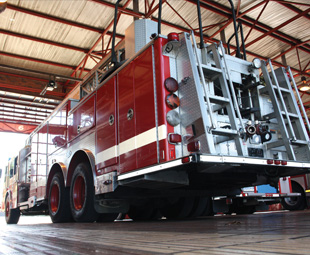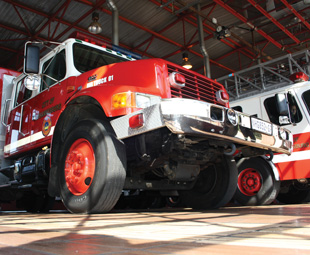Fire engines – the most expensive vehicles on the road

A fire engine is an exciting thing, right? You don’t know the half of it, says DANIELLE DU TOIT, who spent an afternoon with five different types of fire engines at the Sandton Fire Station.
The City of Johannesburg Metropolitan Municipality pro-vides the city with many vital services – including emergency management services, which encompass the city’s fire stations. I was fortunate to spend the afternoon with fire district chief Andries Mucavele at the Sandton Fire Station.
The station has four of its own fire-fighting vehicles, and shares another with the Alexandra Fire Station. The vehicles are complex and more challenging to drive than regular 6×4 truck-tractors. The fire fighters joke that these are the most expensive vehicles on the road, costing upwards of R7 million each.
Each vehicle has a different function, and each is just as important as the next. Often, one cannot perform without its “sister” vehicle.
Let’s start with the most basic – the medium pump, which Mucavele says is used on a day-to-day basis and is based on a Mercedes-Benz chassis. Jaco Keet, administrator for the tender and quotation department at Fire Raiders, which is responsible for most of the fire-fighting vehicles we see on our roads, says the vehicle conversion process is completely application-specific – but that the Mercedes-Benz chassis has proven to be the most reliable over the years. It takes Fire Raiders three to four months to convert a vehicle.
 The company uses aluminium to manufacture most of its superstructures because of its excellent weight-to-strength ratio. “Mild steel might be cheaper, but it doesn’t offer the same characteristics such as being lightweight and rust- and corrosion-resistant,” says Keet.
The company uses aluminium to manufacture most of its superstructures because of its excellent weight-to-strength ratio. “Mild steel might be cheaper, but it doesn’t offer the same characteristics such as being lightweight and rust- and corrosion-resistant,” says Keet.
The medium-pump fire engine holds 3 000 litres of water and 1 000 litres of foam. Fire-fighting foam is used is to cool the fire and cut off the oxygen flow, and is used in where water might add fuel to fire, so to speak, which is common in chemical fires.
Fire Raiders makes use of two types of pumps. The pumps that push water through the hoses are called impeller water pumps, and are driven by their own individual diesel engines. Says Keet: “There are positive displacement pump and piston pumps, and they operate up to 100 kilopascals at a low flow, so 135 l/min. The other type we make use of are centrifugal pumps, which operate at flows from 120 l/min to 13 000 l/min.”
These pressures require that the hoses be made from strong, long-lasting materials. Mucavele says they have hoses ranging from 38 mm to 65 mm thick, depending on the application. “Thank goodness for advancements in technology,” he adds. “The old hoses gave us problems; they had to be completely dry before we could roll them up again. But these new American ones, they work all the time, regardless.”
The medium-pump fire engine is also equipped with the “Jaws of Life” – the hydraulic rescue tool capable of cutting, spreading and forcing steel apart. These tools are often used in motor vehicle accidents where passengers cannot be extricated from the vehicles.
The medium pump is also fitted with six sets of breathing apparatus – pressurised air tanks that enable fire fighters to enter buildings where the air cannot be breathed because of smoke, chemicals or dust.
The medium pump can dump all 3 000 litres of water in under two minutes if required – and this is where the next vital vehicle comes in. Due to the nature of the South Africa’s economic social structure, many areas don’t have access to water and fire hydrants. This naturally presents problems when teams go into such areas to extinguish fires.
 The issue is solved by taking a water tank to call-outs. This is a standard bowser (“mobile water tank”), which is capable of holding 10 000 litres of water and can be hooked up to the medium pump. This vehicle is used simply for supplying water to other fire engines in the event of water shortages. Mucavele says it’s often used in cases of shack fires, which are sadly common and which happen in areas where access to water is invariably limited.
The issue is solved by taking a water tank to call-outs. This is a standard bowser (“mobile water tank”), which is capable of holding 10 000 litres of water and can be hooked up to the medium pump. This vehicle is used simply for supplying water to other fire engines in the event of water shortages. Mucavele says it’s often used in cases of shack fires, which are sadly common and which happen in areas where access to water is invariably limited.
The next vehicle on the list is a hydraulic lift. This is a huge ladder-and-hose configuration mounted onto a truck, in this instance a Scania. The lift is used to extinguish fires in high-rise structures. The tank in this vehicle only holds 1 000 litres of water, so it’s often necessary to hook it up to a hydrant or bowser. The ladder reaches 32 meters which translates into a 15- or 16-story building. Imagine standing on a ladder 16 stories high and holding a hose that is exerting more force than a small horse.
In the case of a high-rise rescue, as opposed to fire-fighting, the Bronto Skylift is called in. This is a vehicle with a ladder and cage mounted onto it. The ladder also reaches about 32 meters high, and the cage is able to hold 400 kg – and can therefore carry about four people, including the fire fighter, down from precarious situations.
When Mucavele talks about the Skylift, I can see that he is pained because their Skylift is about a decade old, and the newer ones can hold about 10 people. He doesn’t say it, but he doesn’t need to – I can tell that he’s thinking about how many times the fire fighters have had to leave people behind in buildings because they cannot accommodate them in the cage. We move on from the topic of the Skylift quickly.
The last vehicle the station depends on, and one that not many know about, is an air truck. This vehicle’s sole purpose is to replenish the air used by the fire fighters when using their breathing apparatus. A pressurised tank carries compressed air as well as extra air tanks. When air in the breathing tanks begins to run low, they are plugged into the air truck and the air is replenished. This vehicle is vital for the fire fighters – but members of the public don’t understand its purpose: Mucavele speaks of glass bottles being thrown at the fire fighters because people want to know why they’re not using that fire engine to extinguish fires.
Each district has five stations and its own fleet manager. “The only time vehicles are not working is when they’ve been in an accident,” says Mucavele. “They are always kept in pristine condition and we never, ever have mechanical problems.”
The men and women who work at the fire stations deserve a mention. People often say they’re grateful for their families, their health and for having food to eat, but we must also be grateful that these types of people exist. There aren’t many who would risk their own lives for the sake of others, and for these fire fighters to do it on daily basis requires a special kind of bravery and a special kind of heart.
Published by
Focus on Transport
focusmagsa



